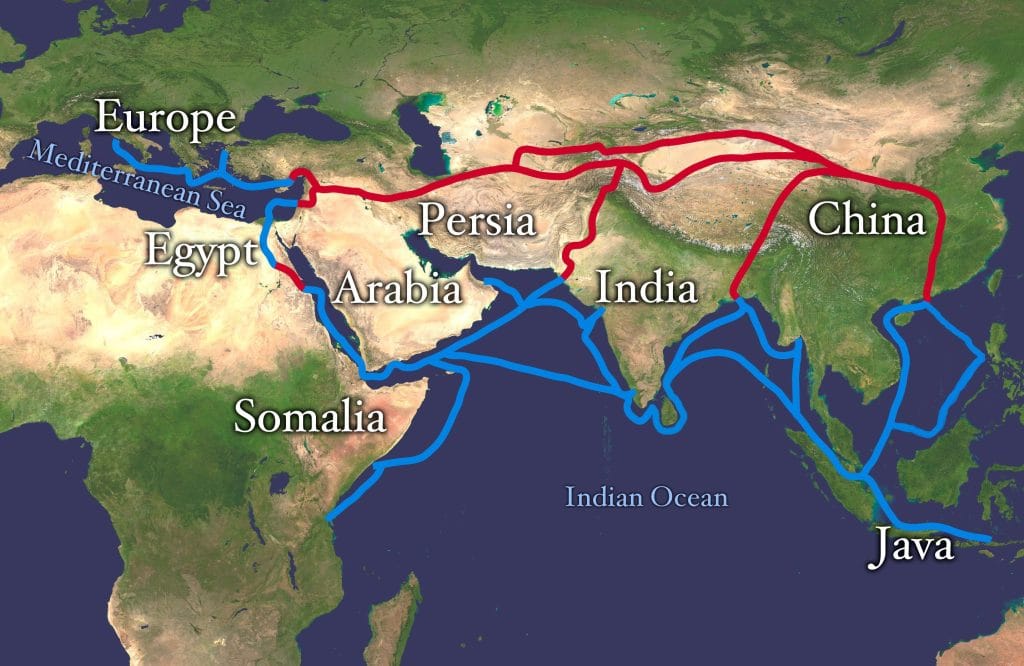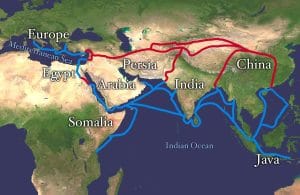The term “Silk Road” conjures images of camel caravans carrying luxurious bolts of silk across vast deserts. While that image is romantic and partly accurate, the real Silk Road was far more complex and significant. It was not a single road but an expansive network of trade routes, both overland and maritime, that connected the East and West for centuries.
This name was coined in the late 19th century by German geographer Ferdinand von Richthofen, inspired by the most famous commodity traded along it: Chinese silk.
Key Things to Know:
- It was a network, not a single road: A web of interconnected paths used by countless merchants and explorers.
- It traded more than just silk: A vast array of goods, ideas, and technologies moved in both directions.
- Its greatest impact was cultural exchange: Perhaps its most important cargo was intangible—religions, knowledge, and art.
The Major Routes
The Silk Road operated through two main corridors:

1. The Overland Silk Road
- Starting Point: Traditionally began in the ancient Chinese capital cities of Chang’an (modern Xi’an) or Luoyang.
- Key Hub: The Hexi Corridor, a crucial valley that led to the gateway of Central Asia.
- Main Branches:
- The Desert Oasis Route: The classic path. It skirted the edges of the treacherous Taklamakan Desert through oasis cities, crossed the Pamir Mountains, and continued through Persia (Iran) before reaching the Mediterranean coast (and Rome).
- The Steppe Route: A northern path through the grassland steppes.
- The Southwest Route: Went from China through modern-day Myanmar and into India.
2. The Maritime Silk Road
- Starting Point: Major Chinese port cities like Quanzhou, Guangzhou, and Ningbo.
- The Route: Ships sailed south through the South China Sea, passed through the Malacca Strait, and crossed the Indian Ocean to reach the Arabian Peninsula, India, and even East Africa.
- Significance: It became increasingly important during the Tang and Song Dynasties, ideal for transporting heavy, fragile goods like ceramics and porcelain (which led to its nickname “the Ceramic Route” in some regions), as well as spices.
What Was Exchanged? (Far More Than Silk)
Goods and Commodities
- From China to the West:Silk (the ultimate luxury good), porcelain, tea, lacquerware, and paper.
- From West to China: Glassware, precious stones (like jade), spices (pepper, cinnamon), gold and silver, horses, and new crops like grapes, walnuts, and sesame.
Technology & Culture
- Into China: Buddhism, Islam, Nestorian Christianity, astronomy, musical instruments (the lute, harp), and sugar refining.
- Out of China: China’s Four Great Inventions—papermaking, printing, gunpowder, and the compass—spread westward, radically altering the course of world history. Silk-making technology and irrigation methods also traveled along these routes.
Disease
Unfortunately, the network also facilitated the spread of pandemics, most notably the Bubonic Plague (the Black Death).
Historical Impact and Legacy
- Civilizational Dialogue: It connected the isolated empires of the ancient world (Han China, Parthia, the Roman Empire, India), creating the first prototype of globalization and fostering an unprecedented exchange of ideas.
- Rise of Cities: It caused the flourishing of great trading cities along its path, such as Samarkand (in modern Uzbekistan), Bukhara, and Dunhuang (in China), which became melting pots of culture.
- Cultural Enrichment: Many aspects of daily life today—from the food we eat to the music we hear—were influenced by this cross-continental exchange.
The Silk Road Today
The spirit of the Silk Road is revived in China’s modern Belt and Road Initiative (BRI), a global development strategy involving infrastructure investment and cooperation. Its two components—the “Silk Road Economic Belt” (overland) and the “21st Century Maritime Silk Road”—draw direct inspiration from this ancient network of exchange.
In summary, the Silk Road was:
- A trade route for valuable commodities.
- A cultural bridge for religions, art, and technology.
- A dialogue of civilizations that fundamentally shaped the development of humanity.
It stands as a powerful historical testament to the idea that connection and exchange, not isolation, are the driving forces of human progress.



Comments